Despite the rising popularity of remote work, we still haven’t fully cracked the code on how to connect with our dispersed workforce. Read on as we cover 10 of the most effective strategies to boost remote employee engagement and build a thriving workplace culture.
As hybrid and remote work models evolve, internal communicators and people leaders face a growing challenge: how to engage remote employees. After all, employee satisfaction and connection go beyond Slack messages, Zoom, and the occasional “fun” Friday.
Engaging remote employees requires more than checking in. It means fostering connection, building trust, and creating moments that remind people they’re part of something bigger.
If you’re wondering how to keep remote employees engaged, the key is to start thinking in terms of meaningful, consistent, two-way communication. Read along as we share how to engage remote workers to increase morale, productivity, and satisfaction.
Take a self-guided tour of ContactMonkey
See how our key features can streamline your internal communications.
Take product tour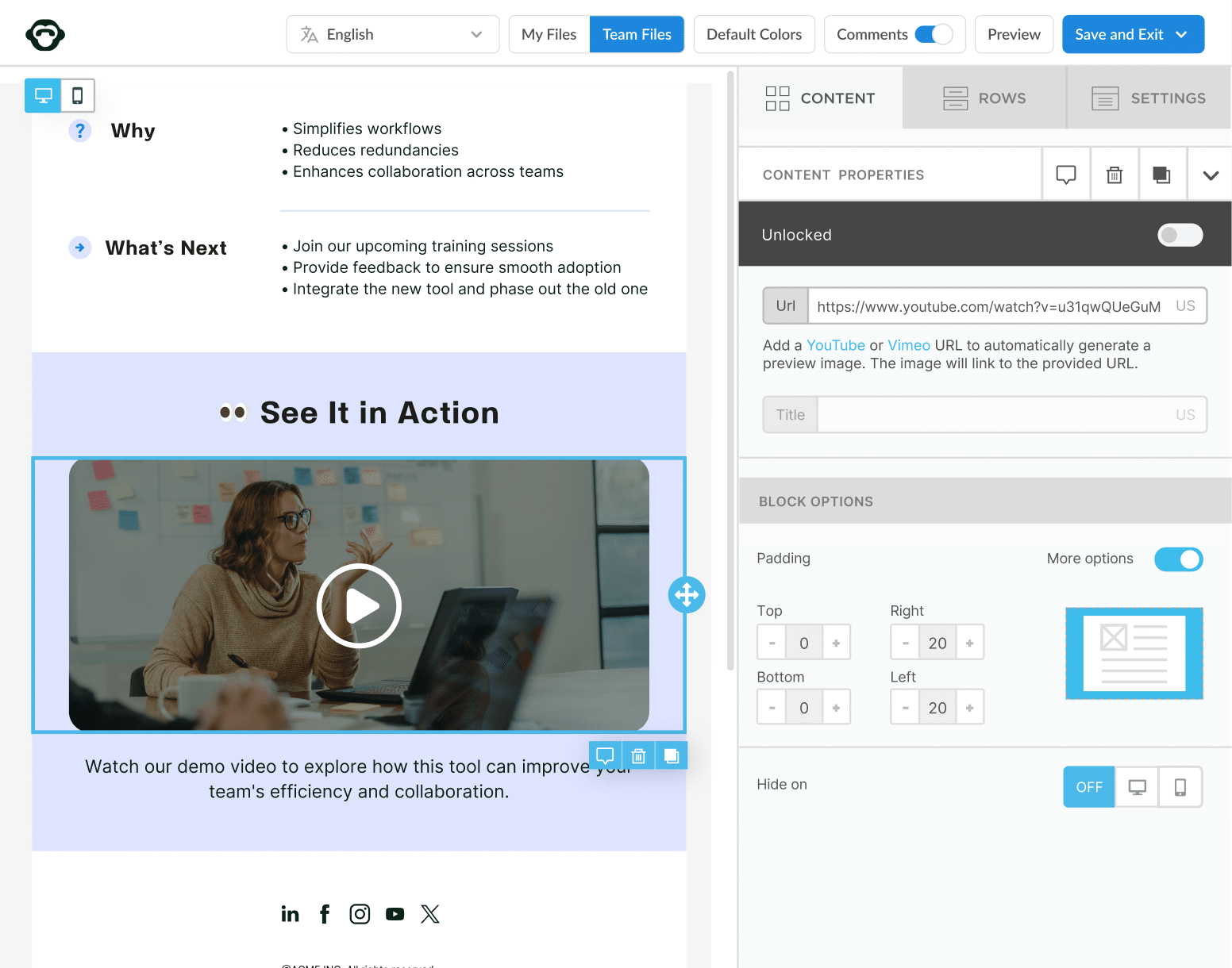
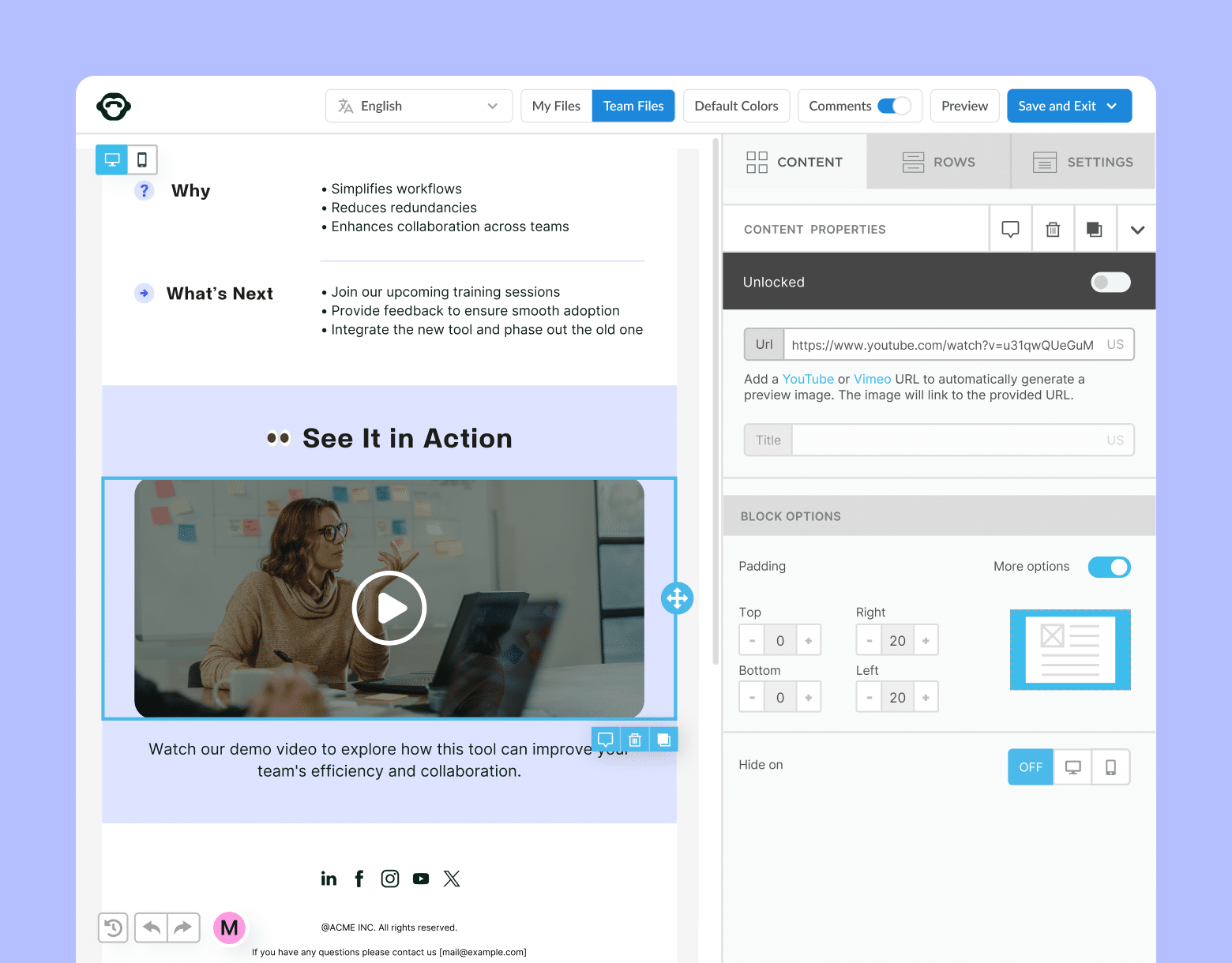
Why Engaging Remote Employees Is So Important
Remote work may have boosted flexibility, but it’s also raised new challenges: isolation, miscommunication, and disconnection from company culture. This is where investing in legitimate remote employee engagement comes into play.
Engaged remote employees are more productive, more loyal, and more likely to go above and beyond—even when no one’s watching. Here are key reasons why engaging remote employees is important:
- Boosts productivity and profitability: Engaged remote employees are more focused, motivated, and likely to go above and beyond in their roles. According to Gallup, companies with high employee engagement see significantly better profitability, customer satisfaction, and operational efficiency. And, if every workplace was fully engaged, it could add $9.6 trillion to the global economy.
- Reduces turnover: When remote workers feel connected and valued, they’re more likely to stay with the company long-term, reducing costly attrition. Helping them understand how their work contributes to broader company goals.
- Strengthens company culture: Consistent engagement efforts reinforce values, build trust, and help remote employees feel part of something bigger than their to-do list.
- Improves mental health and well-being: Disengaged remote workers often feel isolated; keeping them engaged supports emotional resilience and lowers burnout risk.
- Enhances communication: Engaged employees are more likely to contribute, share feedback, and collaborate—creating healthier and more responsive teams.
- Closes the visibility gap: Engagement keeps remote employees in the loop, helping them understand how their work contributes to broader company goals.
How to Engage Remote Workers: 10 Best Practices and Strategies to Implement
Here are 10 proven, actionable strategies to help you master remote employee engagement and build a stronger, more connected virtual workplace.
1. Schedule consistent remote employee check-ins
Checking in isn’t the same as checking up. Weekly or biweekly chats with managers can cover work updates, roadblocks, and even personal wins. These touchpoints don’t need to be long, but they should be thoughtful.
Why this is important for remote employee engagement: Check-ins build trust, increase visibility into workload and wellbeing, and strengthen the manager-employee relationship—especially in remote or hybrid environments.
Tips to action this:
- Encourage managers to schedule recurring 1:1s with each team member
- Use a shared agenda or notes doc to keep conversations focused and productive
- Ask engagement-oriented questions like:
- “What’s something that’s been energizing you lately?”
- “What support would help you feel more successful this week?”
- “Is there anything slowing you down that I can help with?”
- “What’s something that’s been energizing you lately?”
What to watch out for: Don’t let check-ins become robotic status updates. Avoid skipping emotional and relational cues—this is where connection is built.
How to measure success:
- Track the frequency of 1:1s in your internal calendar system or through meeting analytics.
- Use employee pulse surveys to ask: “Do you feel supported by your manager?”
- Monitor feedback quality and engagement trends over time using ContactMonkey analytics.
PRO TIP: Try using ContactMonkey’s Employee Engagement Feedback Features to automate pulse check-ins and gather feedback on how these meetings are going.
Start two-way conversations and employee feedback loops
Learn how to engage staff with pulse surveys, content ratings and reactions, custom polls, and more. Ready to send modern emails?
See engagement features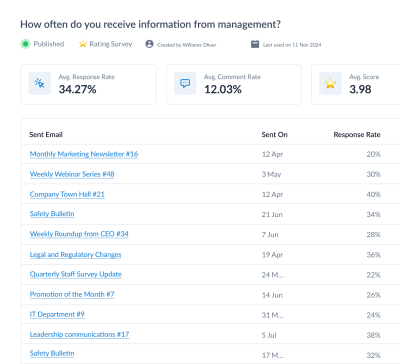
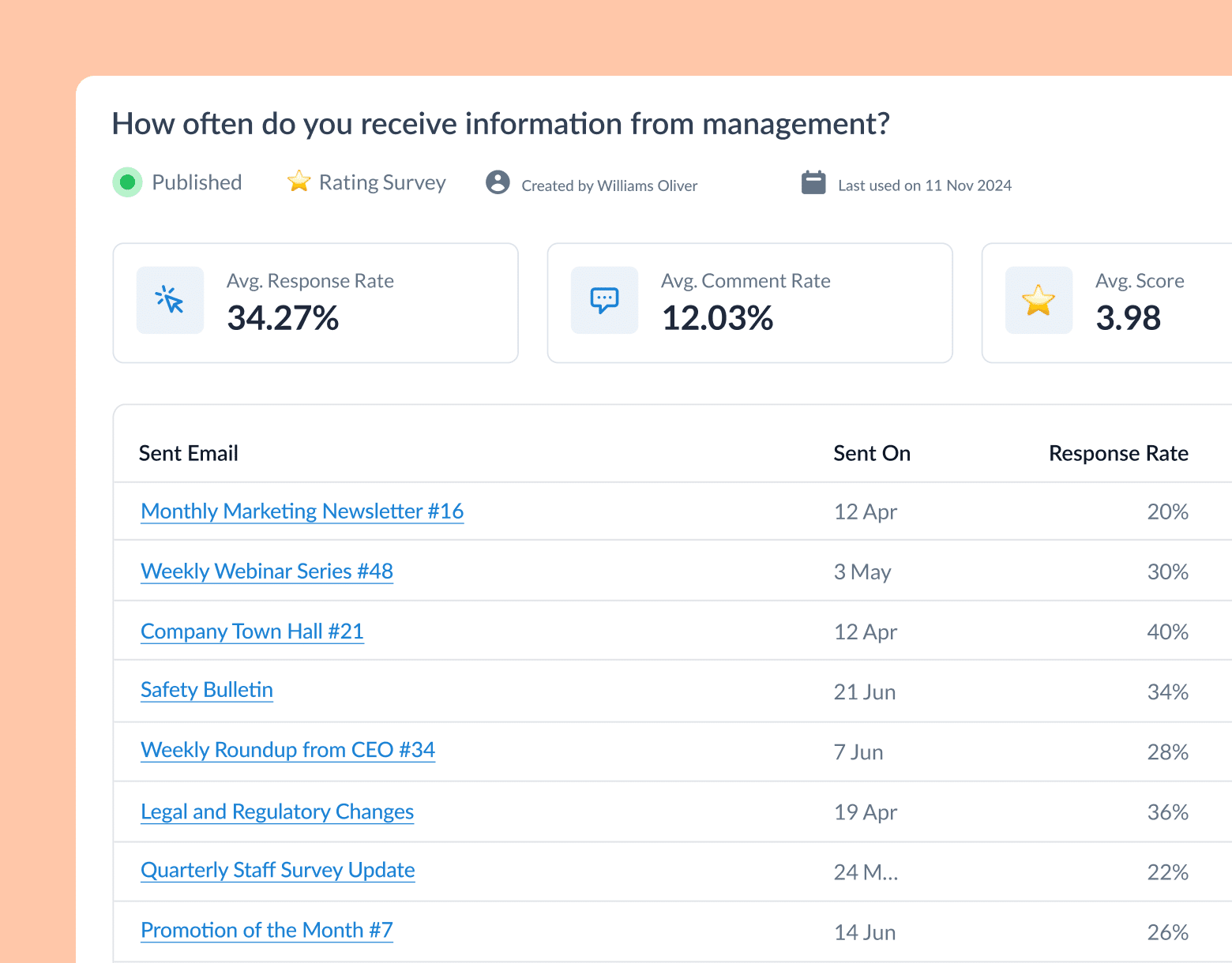
2. Recognize remote employee achievements publicly—and authentically
Recognition is one of the most effective (and overlooked) ways to improve remote employee engagement. Remote workers often miss out on those spontaneous “great job!” moments that happen in-office.
A thoughtful shoutout in your employee newsletter or a quick note from leadership can go a long way in keeping remote employees engaged and motivated.
Why this is important for remote employee engagement: Recognition builds connection, drives motivation, and reminds remote workers that their efforts aren’t going unnoticed—despite the physical distance.
Tips to action this:
- Add a “Win of the Week” or “Team Shoutouts” section to your internal newsletter.
- Let teammates nominate each other for peer recognition.
- Encourage leadership to send out personalized notes or short videos.
What to watch out for: Don’t default to generic praise. “Great job!” isn’t as meaningful as specific, personal acknowledgment tied to impact.
How to measure success:
- Monitor participation in peer recognition programs or newsletter features.
- Use pulse surveys to ask: “Do you feel your work is recognized and appreciated?”
- Track engagement levels before and after introducing recognition initiatives.
BONUS: Use fun and creative employee recognition ideas to generate engagement and leave your employees feeling like they’ve just received a real mood boost!
3. Create space for virtual team building
Virtual team building doesn’t have to mean awkward icebreakers or forced fun. When done intentionally, these activities can strengthen trust, collaboration, and morale—key ingredients for keeping remote employees engaged. The best remote employee engagement ideas bring people together in ways that feel natural and aligned with your company culture.
Why this is important for remote employee engagement: Remote employees often feel isolated from their teammates. Facilitating casual interaction helps build social bonds, reduces feelings of disconnection, and boosts team performance.
Tips to action this:
- Host monthly virtual socials like trivia, cooking classes, or coffee chats.
- Rotate event planning between departments to increase buy-in and variety.
- Use Slack channels or Teams groups for casual prompts (e.g., “Photo of your workspace today”).
What to watch out for: Avoid mandatory events or over-scheduling. Team building should be enjoyable, not another task on the calendar.
How to measure success:
- Track attendance and participation in virtual events.
- Use surveys to ask: “Do you feel connected to your teammates?”
- Compare team sentiment before and after regular social activities.
BONUS: Since email is still a widely used channel for remote employees, check out these ideas to engage remote employees with email.
Watch ContactMonkey LIVE in action
Join live demo
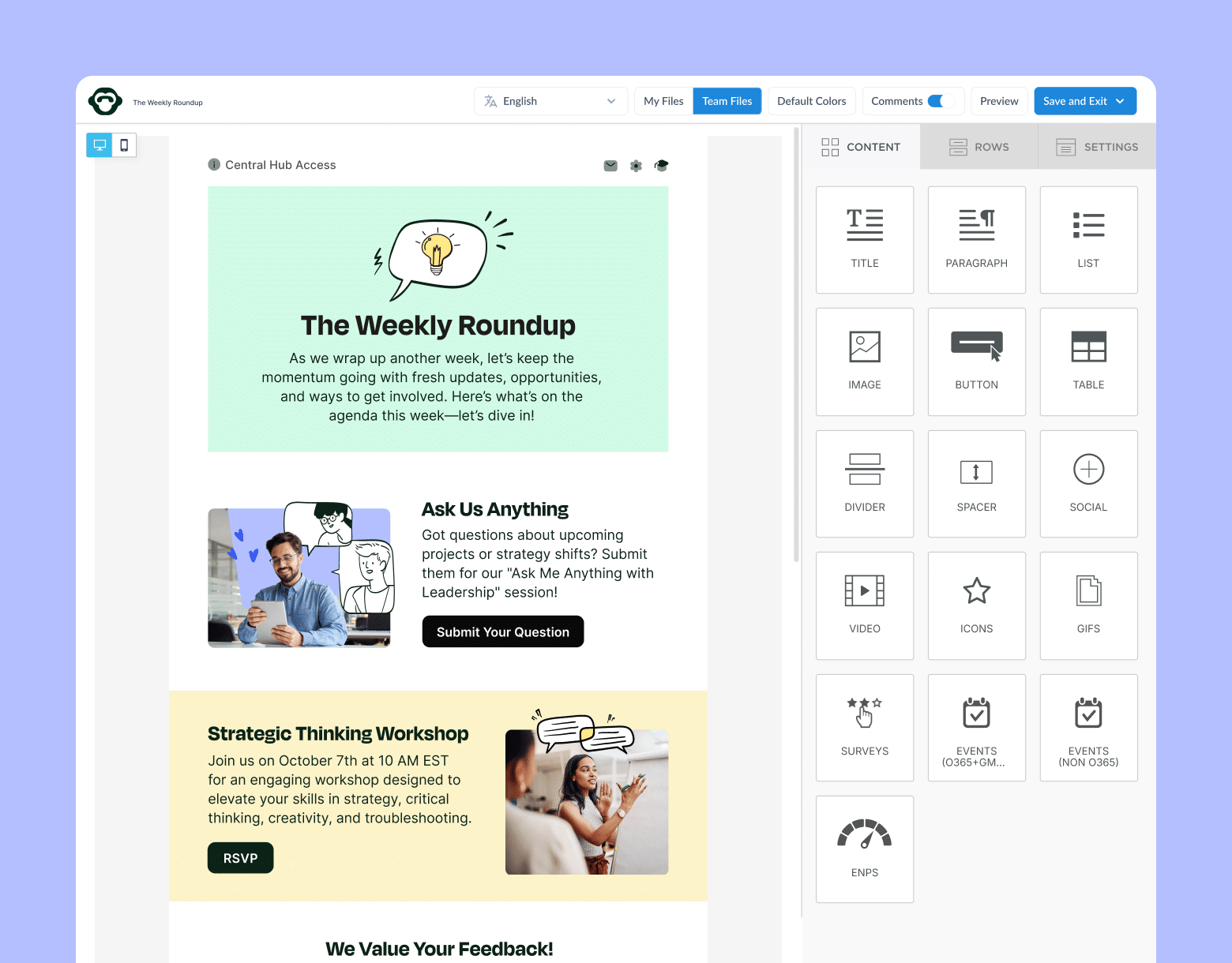
4. Prioritize remote employee feedback (then act on it)
Feedback is a two-way street. Especially for engaging remote employees, you need to generate an employee feedback loop for engagement success. If employees feel like their input disappears into a void, they’ll stop offering it. Remote employee engagement thrives when feedback is actively encouraged, acknowledged, and followed up with visible action.
Why this is important for remote employee engagement: Regular feedback builds trust and shows remote employees that their voices matter. It also gives leadership critical insight into morale, blockers, and team needs.
Tips to action this:
- Send monthly pulse surveys using clear, purposeful employee engagement survey questions.
- Share a “why we did this” summary to show how feedback is driving decisions.
- Open anonymous channels for sensitive or candid suggestions.
What to watch out for: Don’t ask for feedback if you’re not prepared to follow up. The fastest way to disengage remote workers is to ignore their input.
How to measure success:
- Monitor survey participation and response quality.
- Ask, “Do you feel leadership listens and acts on employee feedback?” in quarterly surveys.
- Track improvements in engagement metrics tied to feedback-based changes.
5. Set clear goals and expectations for remote employee engagement
When you’re not physically in the same space, clarity becomes everything. Ambiguity breeds anxiety—and for remote employees, it can seriously damage engagement. Clear, documented expectations help align everyone around priorities, performance standards, and timelines.
Why this is important for remote employee engagement: Remote workers can’t rely on hallway conversations or spontaneous check-ins. Clear expectations reduce misunderstandings and empower employees to make progress independently.
Tips to action this:
- Create shared project briefs with deadlines, owners, and goals.
- Review expectations during weekly one-on-ones.
- Include performance goals in internal newsletters or team updates.
What to watch out for: Don’t assume clarity. Even high performers need consistent communication and reminders.
How to measure success:
- Ask, “Do you feel clear on what’s expected of you each week?” in pulse surveys.
- Monitor missed deadlines or repeated questions as signs of unclear direction.
- Use newsletter open rates and click-throughs to gauge if updates are being seen.
BONUS: Leverage our guide on internal email campaign analytics to understand how to use analytics effectivity, and know where you should pivot if internal comms aren’t working to engage.
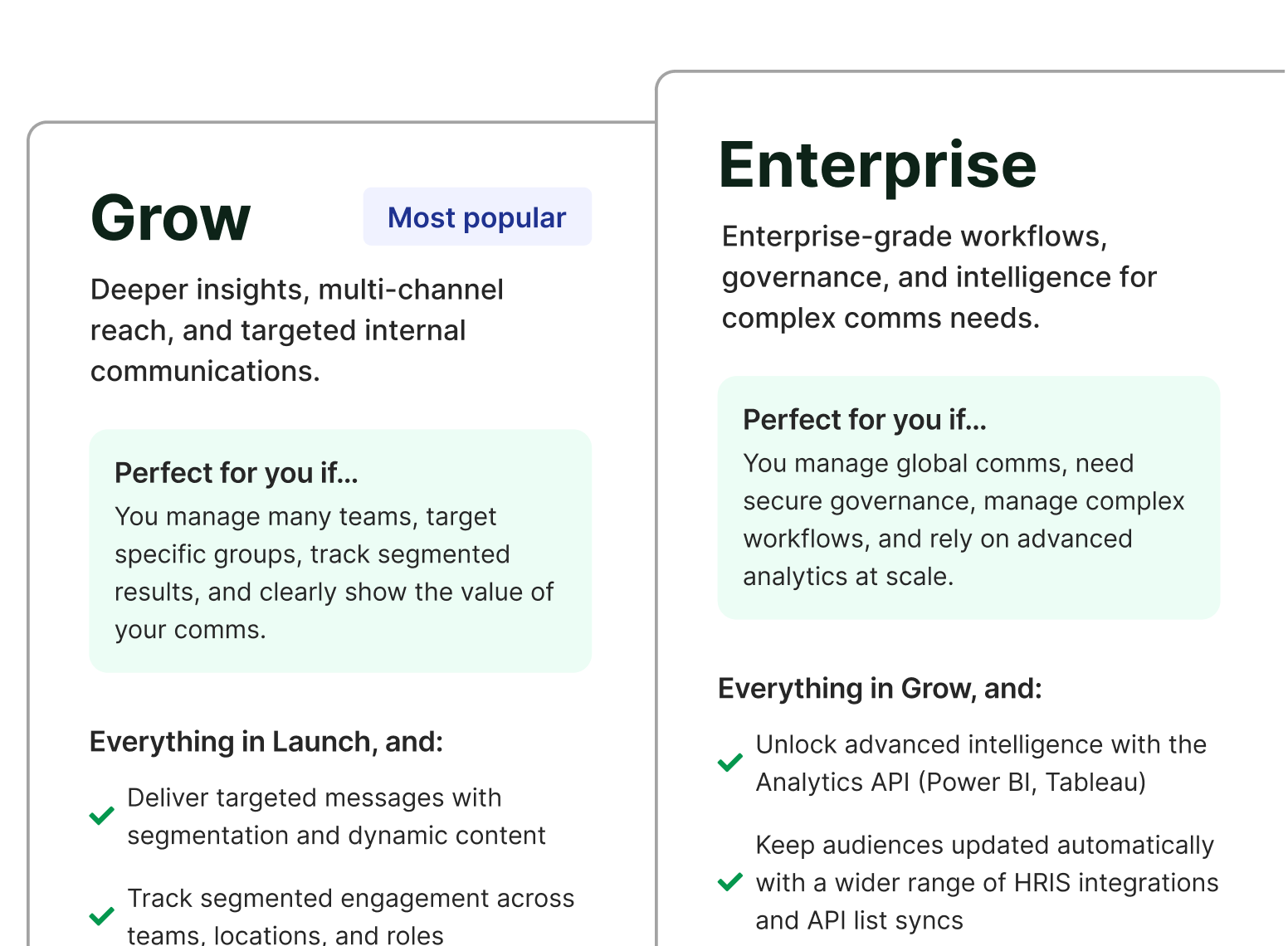
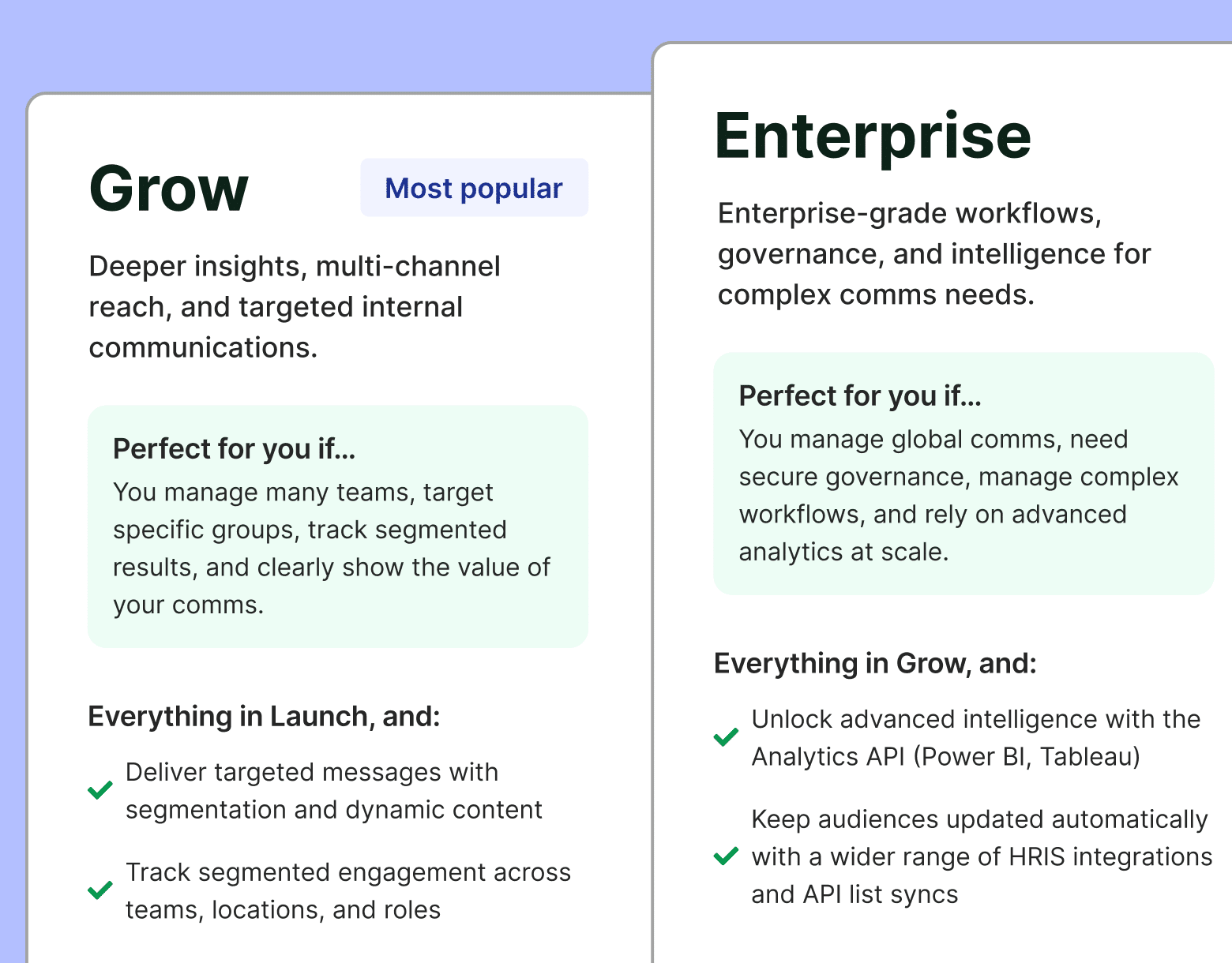
6. Offer flexibility to remote employees
One of the biggest perks of remote work? Flexibility. One of the biggest engagement killers? Not honoring it. Keeping remote employees engaged means respecting that people have different routines, time zones, and home lives.
Why this is important for remote employee engagement: Flexibility builds trust and increases productivity. It tells employees you value outcomes over hours—and it reduces burnout risk.
Tips to action this:
- Allow flexible start/end times within reason.
- Encourage async communication over constant meetings.
- Create core collaboration hours so overlap still happens.
What to watch out for: Don’t mistake flexibility for lack of structure. Employees still need accountability and clarity.
How to measure success:
- Ask, “Do you feel your work schedule supports your productivity and wellbeing?”
- Track employee satisfaction and turnover by department or manager.
- Look for increased survey participation and performance metrics over time.
PRO TIP: Use our List Management Feature to customize updates by location or shift type—keeping flexibility without sacrificing message clarity.
7. Support remote employees’ professional growth
Employees don’t just want to log in—they want to level up. Even remotely. Giving your team access to learning and development opportunities shows that you care about their future, not just their current role.
Why this is important for remote employee engagement: Career development is one of the most powerful employee engagement strategies. It motivates people to stay and grow with your company, especially when working remotely.
Tips to action this:
- Offer stipends for courses, books, or certifications.
- Highlight upcoming workshops or webinars in internal comms.
- Create mentorship programs pairing remote and in-office employees.
What to watch out for: Don’t just offer development resources—make sure they’re accessible and relevant to remote roles.
How to measure success:
- Track participation in training sessions or learning platforms.
- Use pulse surveys to ask, “Do you feel supported in your professional growth?”
- Monitor promotions, internal mobility, and retention metrics.
PRO TIP: Add a “Learning Corner” section to your internal newsletter using ContactMonkey’s drag-and-drop Email Template Builder Feature to highlight upcoming L&D opportunities.
Modern internal comms and measurement tools
No design or technical expertise needed. Save time, increase engagement, and dazzle your employees with fun and interactive communications.
Explore all features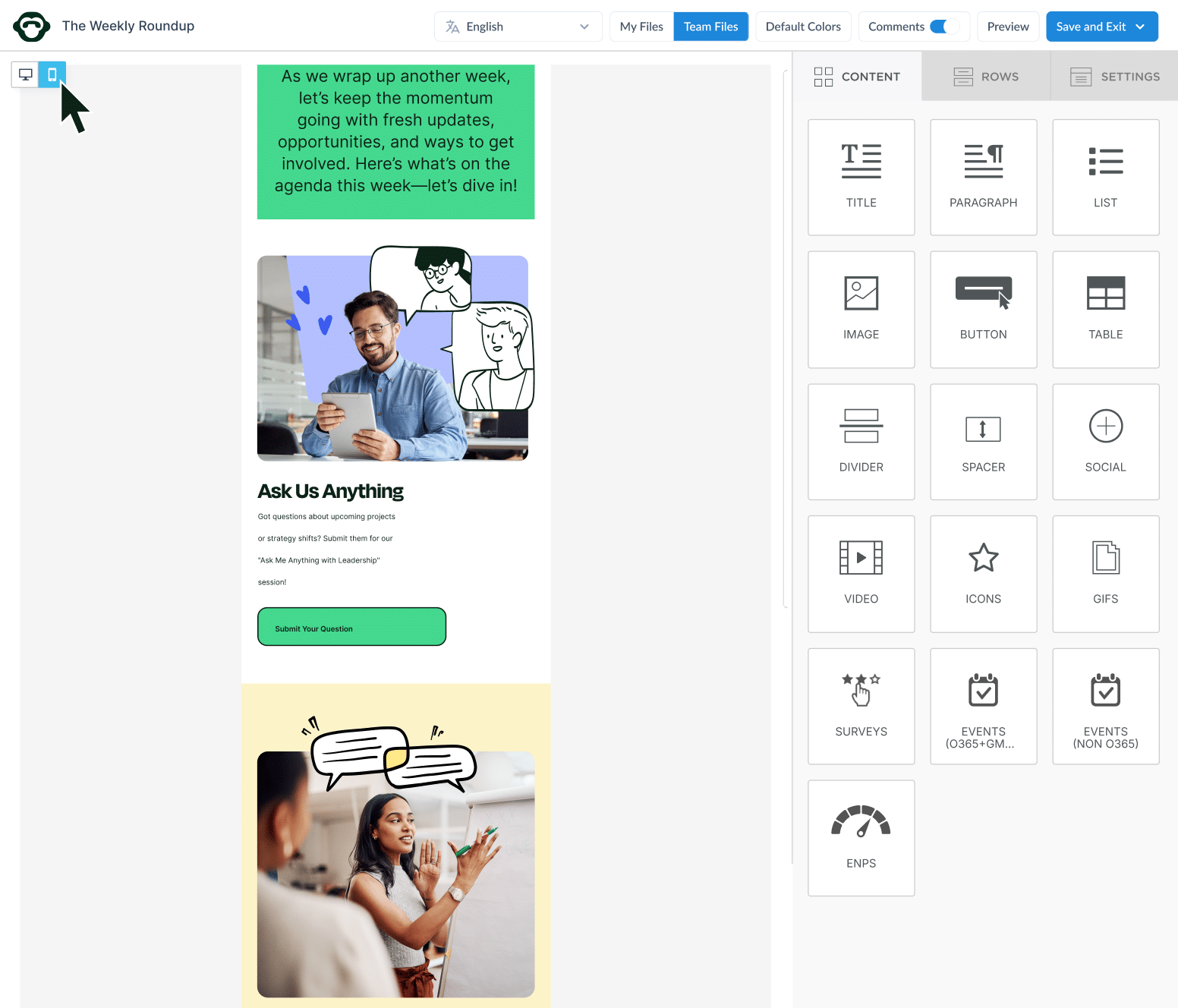
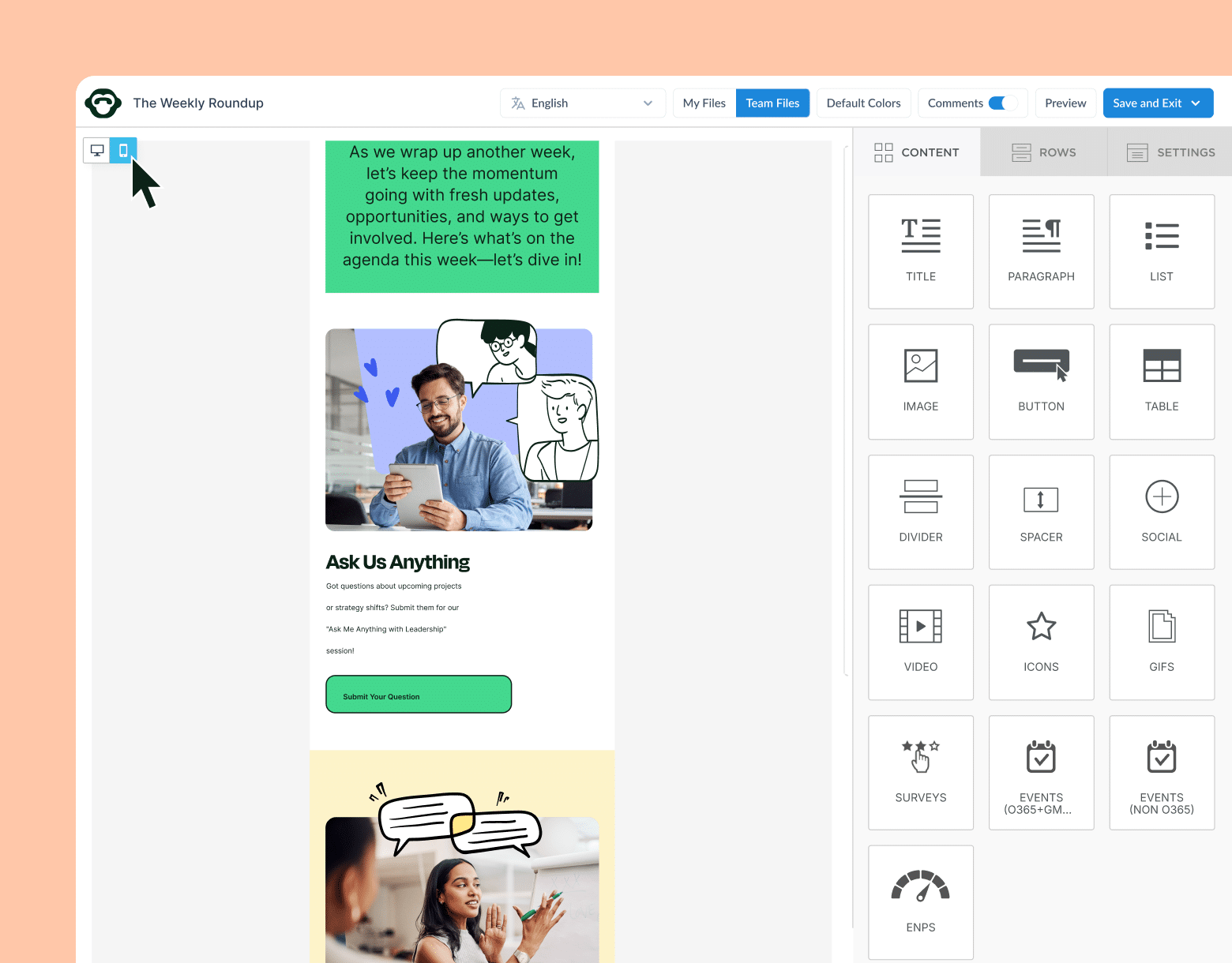
8. Make internal communication human, not corporate
Engaging remote employees starts with talking to them like humans—not just inboxes. If every message sounds like legal copy or a memo, you’re missing a huge opportunity to connect.
Why this is important for remote employee engagement: Tone matters. People are more likely to engage with content that feels personal, authentic, and relatable—especially when working in isolation.
Tips to action this:
- Use plain language and conversational tone in emails.
- Include quotes, emojis, or even GIFs where appropriate.
- Let leaders show personality in video updates or CEO newsletters.
What to watch out for: Don’t overdo it. “Relatable” doesn’t mean unprofessional—find the right voice for your culture.
How to measure success:
- Use ContactMonkey analytics to track open and click rates.
- Test message tone and see which version performs better.
- Survey employees: “Do you find company communications relatable and easy to digest?”
BONUS: Take advantage of these internal communication examples that prioritize human-centric communications to engage remote employees.
9. Keep mental health on the radar for all employees
When your team is remote, stress and burnout can go unseen—and unspoken. Prioritizing mental health is key to remote employee engagement that’s sustainable and genuine.
Why this is important for remote employee engagement: Engaged employees feel supported not just professionally, but personally. Mental wellbeing is a core pillar of what employee engagement truly means in today’s workplace.
Tips to action this:
- Share mental health resources and benefits regularly.
- Encourage “no meeting” days or digital detox time.
- Include check-ins or journaling prompts in newsletters.
What to watch out for: Don’t treat mental health like a one-off campaign. It has to be ongoing and modeled by leadership.
How to measure success:
- Ask in surveys: “Do you feel the company supports your mental wellbeing?”
- Track participation in wellness initiatives.
- Measure burnout risk with pulse checks tied to workload and stress.
PRO TIP: Add a “Wellness Tip of the Week” to your internal email—ContactMonkey makes it easy to drop in reminders, resources, or even mindfulness videos.
Get powerful email analytics and reporting features
Know exactly who is opening and engaging with your employee communications and company newsletters.
Explore analytics & reporting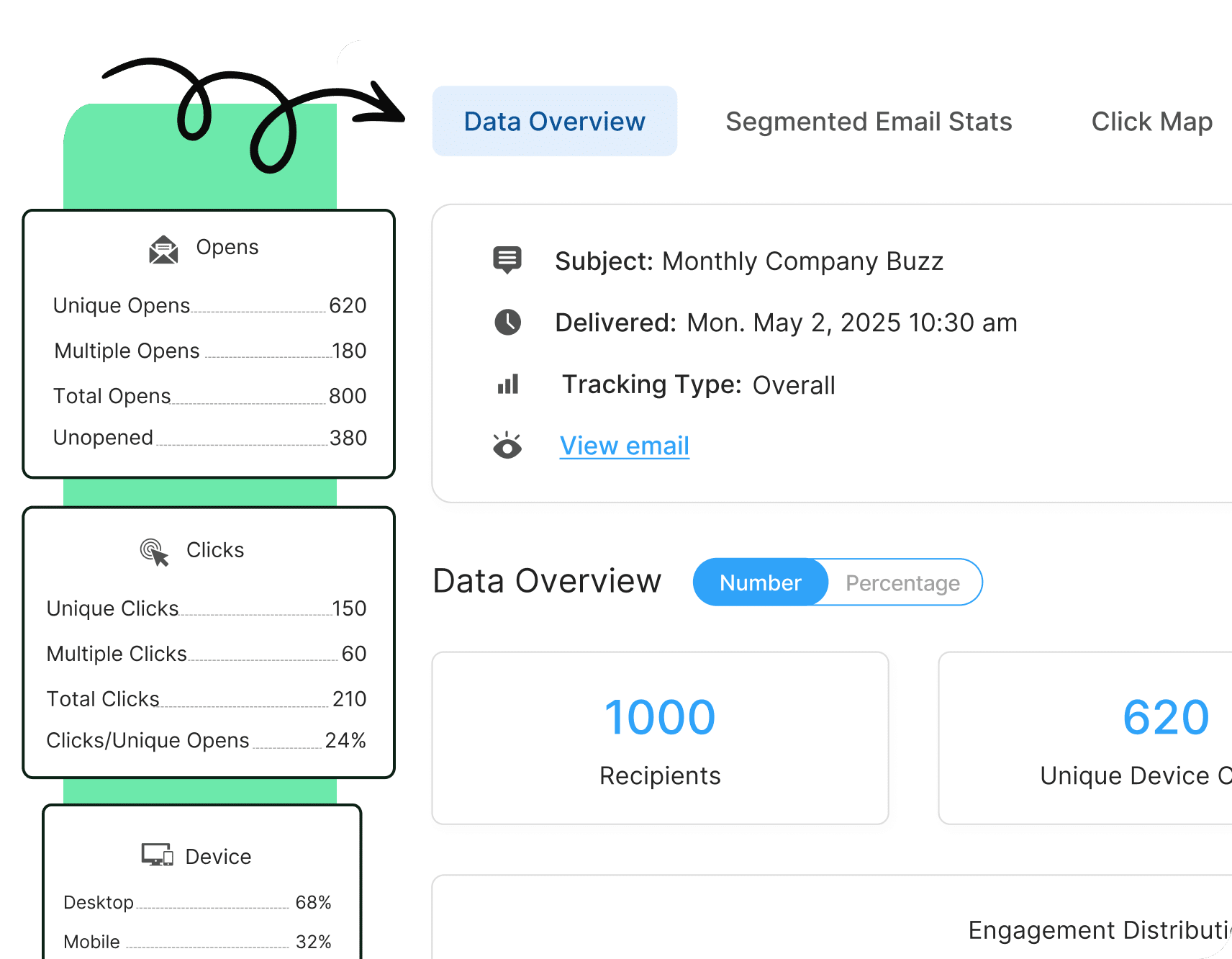
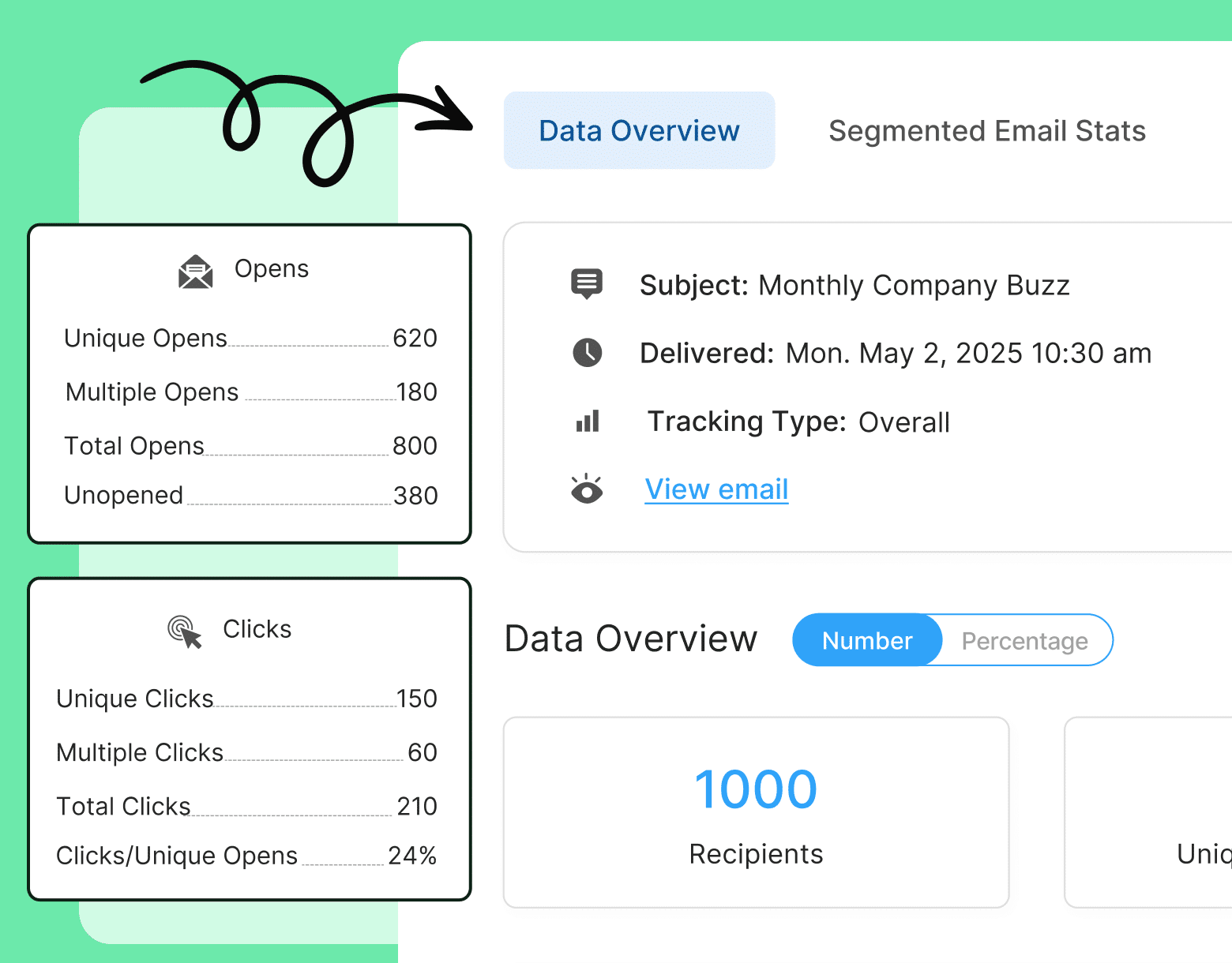
10. Use the right tools to engage remote employees
Even the best content falls flat if it doesn’t reach people. Using dedicated employee engagement software helps centralize your comms, personalize messaging, and track what’s working.
Why this is important for remote employee engagement: Scattered tools = scattered employees. Having a single platform to manage surveys, emails, feedback, and analytics makes your engagement strategy measurable and scalable.
Tips to action this:
- Invest in remote team communication tools like ContactMonkey that integrate with Outlook and Gmail.
- Use list management to target messages by role, location, or team.
- Automate recurring updates (like onboarding or benefits) to save time.
What to watch out for: Avoid using multiple tools that don’t talk to each other—it leads to message fatigue and missed updates.
How to measure success:
- Monitor open and click-through rates with ContactMonkey analytics.
- Track survey response trends and engagement heat maps.
- Measure time saved on content creation with email templates and automations.
PRO TIP: With ContactMonkey, you can build interactive employee newsletters, track performance, and segment messaging—ensuring your remote employee engagement ideas land where they matter most.
The Benefits of Using ContactMonkey to Engage Remote Employees
Remote employee engagement doesn’t happen by accident. It takes consistent effort—and the right tools behind the scenes. If you’re wondering how to engage remote employees at scale while still keeping communication personal, ContactMonkey helps you do exactly that.
Overall, here’s how ContactMonkey supports your remote employee engagement strategies:
- Interactive emails that invite two-way communication: Embed pulse surveys, emojis, star ratings, and anonymous feedback forms directly into internal emails. No external links. No friction.
- Real-time analytics to track what’s working: See open rates, click-throughs, read time, survey participation, and sentiment trends—all in one dashboard. Know exactly how to keep remote employees engaged by spotting what content resonates.
- Multi-language emails for a global workforce: Create and send internal emails in multiple languages with our Multi-language Email Feature—so every employee, no matter where they are, receives communication they can understand and engage with. Perfect for global teams, diverse regions, and multilingual offices.
- Seamless integration with your workflow: Unlike clunky platforms, ContactMonkey works where your team already does—thanks to Outlook or Gmail integration —making it ideal for engaging remote employees without disrupting their day.
- Real results you can measure and improve: With built-in survey tools and engagement tracking, you’ll always know if your remote employee engagement ideas are landing—or need a pivot.
Keep your remote employees engaged with emails, surveys, and SMS designed for dispersed workers. If you’re ready to get started, book a 15-minute call with our team to see how the platform can support your remote employee engagement.



